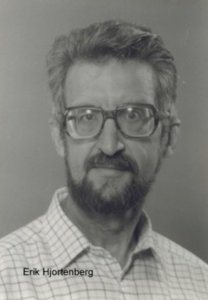Erik Hjortenberg (1930 - 2015)
 Erik Hjortenberg was a big city-person in Copenhagen, but developed very early love for the wild and sometimes furious nature of Greenland. During the International Geophysical Year 1957 -- 58 he volunteered as a student to set up and take care of a new seismograph station in Station Nord, a military base far north. And sitting there he chose to specialize in seismology in the later part of his studies. After his graduation from University of Copenhagen he chose to study geophysics/seismology in Alberta in Canada for a PH.D. degree, which was not available in the educational system in Denmark at the time. Later he went for expeditions and caretaking of seismographs plus wandering vacations in Greenland. He was employed 1963 -- 2000 in seismology in the Geodetic Institute of Denmark, which in 1989 became part of the National Survey and Cadastre of Denmark.
Erik Hjortenberg was a big city-person in Copenhagen, but developed very early love for the wild and sometimes furious nature of Greenland. During the International Geophysical Year 1957 -- 58 he volunteered as a student to set up and take care of a new seismograph station in Station Nord, a military base far north. And sitting there he chose to specialize in seismology in the later part of his studies. After his graduation from University of Copenhagen he chose to study geophysics/seismology in Alberta in Canada for a PH.D. degree, which was not available in the educational system in Denmark at the time. Later he went for expeditions and caretaking of seismographs plus wandering vacations in Greenland. He was employed 1963 -- 2000 in seismology in the Geodetic Institute of Denmark, which in 1989 became part of the National Survey and Cadastre of Denmark.
Erik's thesis was on microseisms, also called seismic noise. And Erik stayed in close contact to that theme within seismology. Based on this specialization Erik has been often co-convener and reporter on progress within this theme, and chair or secretary of working groups. Early in his career he wrote a Bibliography of Microseisms, and later he expanded our data on microseisms via 3-component seismograph studies, via NORSAR array studies, and in attempts to characterize and get rid of noise in detection of signals on Greenland seismographs.
Erik was part of the Danish studies of local earthquakes, participating in field work and in a paper on the earthquakes of Denmark following an earlier review by Inge Lehmann. And this leads to mentioning that Erik was always an admirer of Inge Lehmann, never disagreeing with her. This led to his personal inheritance of Inge Lehmann's scientific, handwritten notes, which have only recently been turned over to the national archives of Denmark. Erik was very keen in Nordic seismological cooperation, and close to the end of his career we noted that he had the record of having been present at all the annual Nordic meetings from the beginning. Late in his career he was the Danish representative in the UN talks in Vienna on detection and discrimination seismology.
Erik was the "nicest person on earth" an expression many of you will have heard me say before. He was always ready with advice for me, when I was getting into seismology, and I noticed he did the same to every student or colleague with just a bit of interest. I have never come into his office to talk about something or to ask a favour without getting the best treatment. He seemed to forget his own engagement to be of service to his colleague. Another characteristic about Erik is that he had an extremely good memory for happenings and details years back. He looked weak, but was much stronger than suggested by the looks. He was fond of and good at mountain walking. And you should have tried to follow him on the bicycle on the paths near his home or his summerhouse!
Erik died quietly in a nursing home near his house in Copenhagen on April 25, 2015, at the age of 84.
Søren Gregersen
